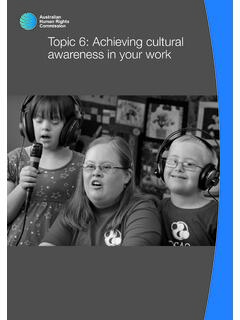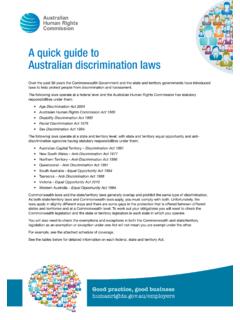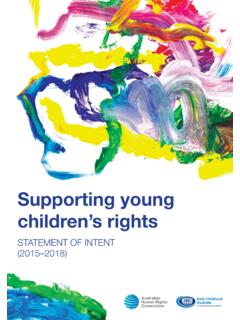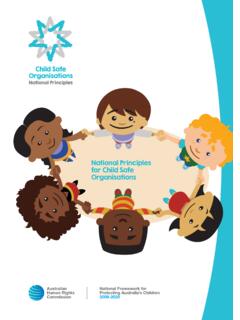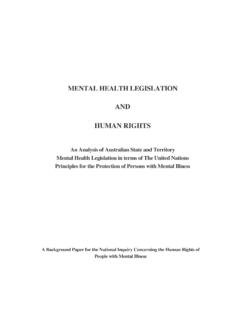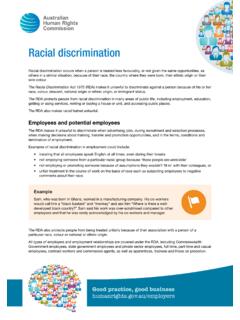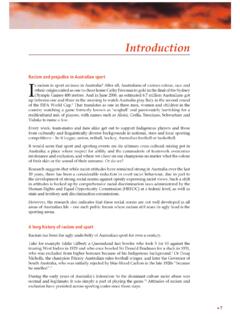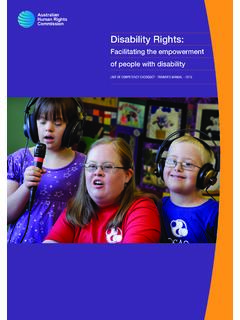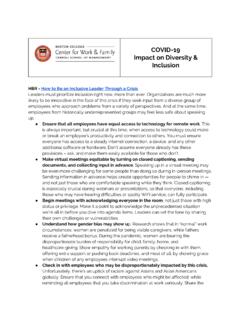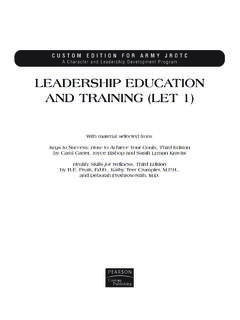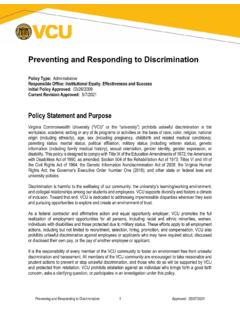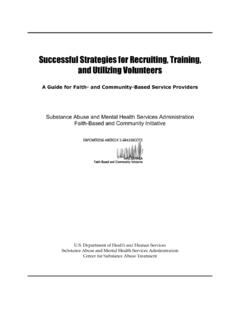Transcription of History - Australian Human Rights Commission
1 Developed by the Human Rights and Equal Opportunity Commission , 2003. 1 A LIFE of opportunity and dignity, free from discrimination and disadvantage, should not be an ideal. It is, in fact, a basic Human right one that we all share in common. Social justice is about making sure that every Australian - Indigenous and non-Indigenous - has choices about how they live and the means to make those choices. Social justice is grounded in the practical, day-to-day realities of life. It s about waking up in a house with running water and proper sanitation; offering one s children an education that helps them develop their potential and respect their culture.
2 It is the prospect of satisfying employment and good health. Social justice also means recognising the distinctive Rights that Indigenous Australians hold as the original peoples of this land, including: the right to a distinct status and culture, which helps maintain and strengthen the identity and spiritual and cultural practices of Indigenous communities the right to self-determination, which is a process where Indigenous communities take control of their future and decide how they will address the issues facing them the right to land, which provides the spiritual and cultural basis of Indigenous communities. The Aboriginal and Torres Strait Islander Social Justice Commissioner advocates for the recognition of the Rights of Indigenous Australians and seeks to promote respect and understanding of these Rights among the broader Australian community.
3 For Indigenous peoples to participate in Australian society as equals requires that we be able to live our lives free from assumptions by others about what is best for us. It requires recognition of our values, culture and traditions so that they can co-exist with those of mainstream society. It requires respecting our difference and celebrating it within the diversity of the nation. Dr William Jonas History In the past decade a number of significant events have helped promote a deeper understanding of the issues facing Indigenous Australians. In 1991 the report of the Royal Commission into Aboriginal Deaths in Custody revealed a complex and devastating picture of the effects of dispossession, colonisation and institutional racism on Aboriginal peoples.
4 Developed by the Human Rights and Equal Opportunity Commission , 2003. 2 Partly in response to the findings of the Royal Commission , the federal Parliament established the Council for Aboriginal Reconciliation which had as its goal the transformation of Aboriginal and non-Aboriginal relations in this country . This was followed in 1992 by the High Court s decision in Mabo, which rejected the idea that Australia was terra nullius ( land belonging to no one ) at the time of European settlement. The Court recognised the common law right of Indigenous peoples to land based on their continuing use and connection to land. Since then other painful episodes in Australia s History have been revealed, such as the findings of the National Inquiry into the Separation of Aboriginal and Torres Strait Islander Children from their Families.
5 The position of the Aboriginal and Torres Strait Islander Social Justice Commissioner was created by the federal parliament in December 1992 a response to the findings of the Royal Commission into Aboriginal Deaths in Custody and the National Inquiry into Racist Violence. It was also a response to the extreme social and economic disadvantage faced by Indigenous Australians. An important role of the Commissioner is to keep Indigenous issues before the federal Government and the Australian community to promote understanding and respect for the Rights of Indigenous Australians. Role and functions The Social Justice Commissioner works to: advocate for the Rights of Indigenous peoples promote an Indigenous perspective on different issues build support and understanding for an Indigenous perspective, and empower Indigenous peoples.
6 A central function of the Commissioner is to report annually to federal Parliament on significant social justice and native title issues facing Indigenous Australians Social Justice Report The Social Justice Report looks at the key Human Rights issues facing Indigenous Australians and makes recommendations about changes to government policies, programs and laws that will help Indigenous Australians more fully enjoy their Rights . It covers issues ranging from self-determination to criminal justice and an annual report card on the reconciliation process. Native Title Report Under the Native Title Act 1993, the Commissioner is required to make a Native Title Report to federal Parliament each year. Through these reports, the Commissioner gives a Human Rights perspective on native title issues and advocates for practical co-existence between Indigenous and non-Indigenous groups in using land.
7 Education and raising awareness The Commissioner works to raise awareness among Indigenous peoples about their Rights . Where appropriate, he joins with other organisations to develop educational initiatives, such as seminars and training programs, and targeted educational resources, such as Tracking your Rights and the National Indigenous Legal Advocacy Courses. The Commissioner also seeks to raise awareness about Indigenous issues with the broader Australian community. Developed by the Human Rights and Equal Opportunity Commission , 2003. 3 International recognition of Indigenous Rights The Commissioner participates in international forums to discuss issues facing Indigenous peoples from around the world.
8 He contributes to reports that Australia is required to submit to United Nations committees on Human Rights issues affecting Aboriginal and Torres Strait Islander peoples, as well as making independent submissions to these committees. Other responsibilities of the Commissioner The Commissioner also has a responsibility to: review laws and policies and provide advice to the federal, state and territory governments consult with Indigenous and non-Indigenous organisations and Indigenous communities to get their views and expertise on different issues respond to requests for media interviews and speeches to raise Indigenous issues with the Australian community. As a member of the Human Rights and Equal Opportunity Commission , the Commissioner works closely with others in the organisation to promote and protect the Rights of Indigenous Australians.
9 This happens in a variety of ways, such as participating in significant court cases through the Commission s amicus curie and intervention functions and holding public inquiries into issues of national importance. The Social Justice Commissioner is not able to receive complaints from individuals. However, the President of the Human Rights and Equal Opportunity Commission does have a complaint handling role under anti-discrimination laws. Major issues Reconciliation Reconciliation is based on Indigenous and non-Indigenous Australians coming to an honest understanding of our shared History , a commitment to building cooperative partnerships based on trust and respect and a recognition of the distinctive Rights of Indigenous peoples.
10 The formal reconciliation process started in 1991 with the establishment of the Council for Aboriginal Reconciliation. Ten years later the Council presented the federal Government with a Roadmap to Reconciliation and Final Report to Parliament, which contain a comprehensive set of practical and symbolic steps to be taken. Whilst community support for reconciliation remains high, the federal Government s support for practical reconciliation with its primary focus on overcoming Indigenous disadvantage has meant that important questions about the Rights of Indigenous Australians have been left unanswered. To keep the reconciliation process moving forward, a number of groups, including the Social Justice Commissioner, are working together to set performance benchmarks to monitor the responses of governments to the recommendations of the Council for Aboriginal Reconciliation.
